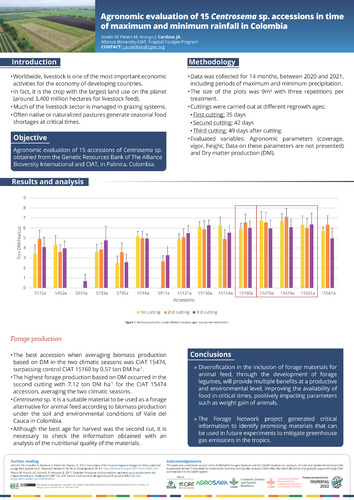Agronomic evaluation of 15 Centrosema sp. accessions in time of maximum and minimum rainfall in Colombia
Much of the tropical livestock sector is managed in extensive grazing systems and in most cases with native and/or naturalized germplasm. Management practices in livestock farms do not only include the rotation of paddocks, adequate periods of occupation and rest, and the pasture areas are competing with other uses for land (e.g., deforestation, crops). That is why it is necessary to introduce new forage germplasm, which adapts to adverse conditions, provides excellent nutritional quality, and allows intensifying livestock systems, freeing areas used for grazing to be used as a reforestation area or for planting crops, among others. The objective of this study was evaluating the agronomic and productive behaviour of a collection of 15 accessions of Centrosema spp. in two climatically contrasting seasons and with three regrowth ages (Cut 1:35, cut 2: 42 and cut 3: 49 days post-cut). According to the information obtained in the study in terms of biomass production of each accession averaging the two climatic seasons, it was found that the accession that presented the best performance in terms of biomass based on dry matter (DM) was CIAT 15474 in the Cut 2. with a forage offer of 7.12 ton DM/ha/cut, surpassing the control (CIAT 15160) that produced 6.55 ton DM/ha/cut. These data indicate that the accession that emerged is a promising option for adoption in livestock systems in Latin America. However, it is recommended to compare the information obtained with the results of other related research in order to identify production niches for it. Likewise it is recommended to conduct studies on seed production and dissemination with producers to facilitate adoption processes.

